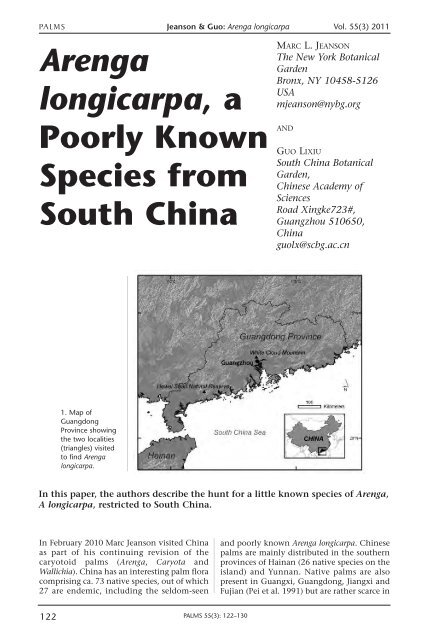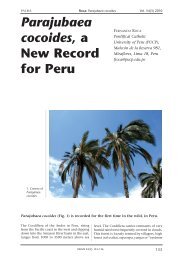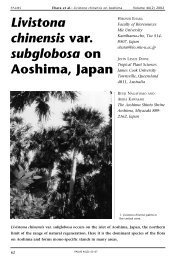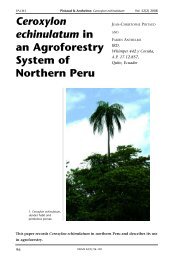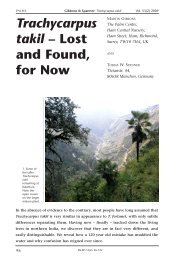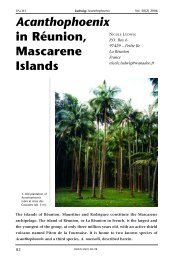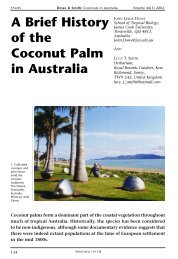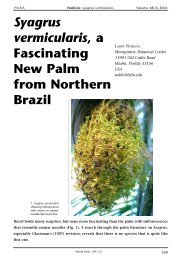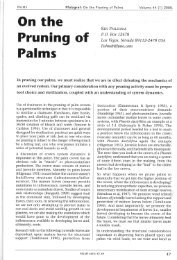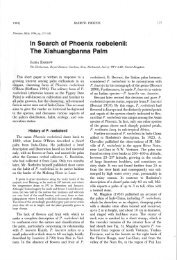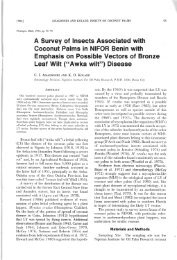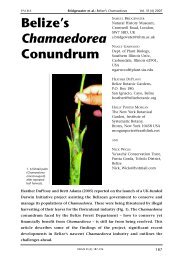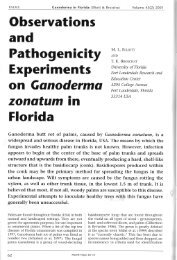Arenga longicarpa, a Poorly Known Species from South China
Arenga longicarpa, a Poorly Known Species from South China
Arenga longicarpa, a Poorly Known Species from South China
You also want an ePaper? Increase the reach of your titles
YUMPU automatically turns print PDFs into web optimized ePapers that Google loves.
PALMS Jeanson & Guo: <strong>Arenga</strong> <strong>longicarpa</strong> Vol. 55(3) 2011<br />
<strong>Arenga</strong><br />
<strong>longicarpa</strong>, a<br />
<strong>Poorly</strong> <strong>Known</strong><br />
<strong>Species</strong> <strong>from</strong><br />
<strong>South</strong> <strong>China</strong><br />
MARC L. JEANSON<br />
The New York Botanical<br />
Garden<br />
Bronx, NY 10458-5126<br />
USA<br />
mjeanson@nybg.org<br />
AND<br />
GUO LIXIU<br />
<strong>South</strong> <strong>China</strong> Botanical<br />
Garden,<br />
Chinese Academy of<br />
Sciences<br />
Road Xingke723#,<br />
Guangzhou 510650,<br />
<strong>China</strong><br />
guolx@scbg.ac.cn<br />
1. Map of<br />
Guangdong<br />
Province showing<br />
the two localities<br />
(triangles) visited<br />
to find <strong>Arenga</strong><br />
<strong>longicarpa</strong>.<br />
In this paper, the authors describe the hunt for a little known species of <strong>Arenga</strong>,<br />
A <strong>longicarpa</strong>, restricted to <strong>South</strong> <strong>China</strong>.<br />
In February 2010 Marc Jeanson visited <strong>China</strong><br />
as part of his continuing revision of the<br />
caryotoid palms (<strong>Arenga</strong>, Caryota and<br />
Wallichia). <strong>China</strong> has an interesting palm flora<br />
comprising ca. 73 native species, out of which<br />
27 are endemic, including the seldom-seen<br />
and poorly known <strong>Arenga</strong> <strong>longicarpa</strong>. Chinese<br />
palms are mainly distributed in the southern<br />
provinces of Hainan (26 native species on the<br />
island) and Yunnan. Native palms are also<br />
present in Guangxi, Guangdong, Jiangxi and<br />
Fujian (Pei et al. 1991) but are rather scarce in<br />
122<br />
PALMS 55(3): 122–130
PALMS Jeanson & Guo: <strong>Arenga</strong> <strong>longicarpa</strong> Vol. 55(3) 2011<br />
2. Caryota maxima, a common palm in Guangdong province.<br />
these provinces (Henderson 2009). Some of<br />
them, however, are particularly noteworthy,<br />
such as Guihaia in Guangxi (Dransfield et al.<br />
1985).<br />
The first stop on Jeanson’s itinerary was<br />
Guangdong Province (Fig.1), to visit the type<br />
locality of a large Caryota (Fig. 2) described as<br />
Caryota ochlandra by Hance in 1879. Govaerts<br />
and Dransfield (2005) considered this name<br />
to be a synonym of Caryota maxima Blume ex.<br />
Mart. This palm is very common in the area<br />
of Dinghu Shan and is, without a doubt,<br />
conspecific with Caryota maxima.<br />
Our next item on the agenda was the illusive<br />
<strong>Arenga</strong> <strong>longicarpa</strong>. This species was described in<br />
1989 (Wei 1989) based on the study of only<br />
four specimens (including the type). The first<br />
collection of this palm was made by Otto<br />
Kuntze on White Cloud Mountain (Baiyun<br />
Shan) (Fig.1) in 1875, and his specimen is in<br />
123
PALMS Jeanson & Guo: <strong>Arenga</strong> <strong>longicarpa</strong> Vol. 55(3) 2011<br />
the New York Botanical Garden herbarium but<br />
was not a basis for the original description.<br />
One specimen cited in the protologue (<strong>South</strong><br />
<strong>China</strong> Inst. Bot. Exped. 383971) was collected in<br />
Taishan County in 1973 but was not seen in<br />
the herbarium of that institute, IBSC. The<br />
other two cited specimens and the type were<br />
collected in the same locality, Mt. Heweishan<br />
(Fig.1) (in the Heweishan Natural Reserve) in<br />
Dianbai County. Collections were made in<br />
1980, 1984 and 1985. Because this species had<br />
not been collected since 1985, little<br />
information – and no DNA material – was<br />
available. Prior to the publication of his field<br />
guide of palms of southern Asia (Henderson<br />
2009), Andrew Henderson visited the region<br />
but was unable to find this species.<br />
During Jeanson’s two week trip, two out of the<br />
three localities known <strong>from</strong> herbarium<br />
specimens were visited. After several days in<br />
the <strong>South</strong> <strong>China</strong> Botanical Garden checking<br />
the specimens in the herbarium, including the<br />
type specimen, Liu Qian, a student <strong>from</strong><br />
Nanjing Agriculture University investigated<br />
Mt. Baiyun Shan (White Cloud Mountain).<br />
The mountain is located at approximately 17<br />
kilometers north of Guangzhou city: it is now<br />
totally integrated in the huge suburban area<br />
surrounding Guangzhou. We tried as much as<br />
possible to investigate areas far <strong>from</strong> the<br />
touristic trails and roads filled with people<br />
during the Chinese New Year holidays,<br />
emphasizing especially the streams banks, a<br />
habitat often preferred by <strong>Arenga</strong> species. We<br />
ended up lost and finally met a group of people<br />
asking us to leave immediately because we<br />
were in a forbidden area; we were unaware<br />
that we had entered a military zone. We<br />
followed their directions for the quickest way<br />
to get out, and after five hours of exploration<br />
on the mountain, decided that we would end<br />
our search in this locality. From what we had<br />
observed, most of the non-cultivated<br />
vegetation on Baiyun Shan is secondary, and<br />
<strong>Arenga</strong> <strong>longicarpa</strong> seems absent in this place<br />
(although we did not investigate the northern<br />
part of the park). Since the 1970s, Guangzhou<br />
was massively urbanized, and the forest of<br />
Baiyunshan was largely replanted, which could<br />
explain the absence of this species since<br />
Kuntze’s collection.<br />
After Baiyun Shan, we visited the locality<br />
where three collections were made in Dianbai<br />
county. The first day, after a six hour trip <strong>from</strong><br />
Guangzhou, we followed our guide through<br />
the Heweishan Natural Reserve where he took<br />
us to Caryota mitis and Caryota maxima, two<br />
other representatives of tribe Caryoteae in this<br />
area. These two species were unfortunately the<br />
only species our guide could locate after having<br />
read the description. We were a bit desperate<br />
to find <strong>Arenga</strong> <strong>longicarpa</strong> after having seen the<br />
3. Habitat of <strong>Arenga</strong> <strong>longicarpa</strong> in Heweishan Natural Reserve.<br />
124
PALMS Jeanson & Guo: <strong>Arenga</strong> <strong>longicarpa</strong> Vol. 55(3) 2011<br />
4. <strong>Arenga</strong> <strong>longicarpa</strong>. Top left: habit of a mature individual; top right: detail of the leaflets; bottom left: unripe<br />
fruits; bottom right: seedling.<br />
desolate and highly modified landscapes of<br />
the southern part of Heweishan Natural<br />
Reserve. Again, our first instinct was to focus<br />
our time and attention on the banks of streams<br />
in the area (Fig. 3). A dam was built and created<br />
an artificial lake (Xiaoshui Brook). We decided<br />
to survey the downstream banks and quickly<br />
discovered, at about 295 m altitude, a small<br />
population of perhaps ten different clumps of<br />
<strong>Arenga</strong> <strong>longicarpa</strong>, which allowed us to make<br />
herbarium collections and to update the<br />
description (Fig. 4).<br />
The day after, we decided to go further north<br />
to see if the species could be found at higher<br />
elevations as indicated on the herbarium<br />
labels, one of which said the palm grew at 750<br />
m. We followed a trail across a vast area that<br />
125
PALMS Jeanson & Guo: <strong>Arenga</strong> <strong>longicarpa</strong> Vol. 55(3) 2011<br />
5. Pristine forest above 700 m elevation in Heweishan Natural Forest.<br />
was formerly a conifer plantation. The trees<br />
had been devastated by a disease and then by<br />
a fire a short time before our visit, which gave<br />
the entire area a lunar landscape aspect. At<br />
about 700 m altitude, the forest reappeared<br />
and looked pristine (Fig. 5). The contrast was<br />
striking between the zone we just walked<br />
through and the beauty of the landscape we<br />
now faced. We walked for hours along different<br />
mountain streams but unfortunately did not<br />
find any other population of <strong>Arenga</strong> <strong>longicarpa</strong>.<br />
More field work is necessary to determine<br />
whether this species is present at this altitude<br />
range, where Calamus rhabdocladus (Fig. 6) is<br />
common.<br />
<strong>Arenga</strong> <strong>longicarpa</strong> C.F. Wei, Acta Bot. Austro<br />
Sin. 4: 7. 1989. TYPE: CHINA, Guangdong,<br />
Taishan, C.F. Wei 123250 (holotype: IBSC!).<br />
Shrub, 2–3 m high. Stems, when developed,<br />
clustered, to 50–60 cm high, 1–2 cm diam., to<br />
7 cm with sheaths. Leaves 10–12, all along the<br />
stem, 2–2.5 m long, sheaths 20–25 cm long,<br />
disintegrating into brown/black fibers covering<br />
the stem; petiole rounded, 120–135 cm long,<br />
rachis 70–90 cm long, middle blade ca. 45 cm<br />
wide. Pinnae ca. 12 per side, mostly clustered<br />
in groups of 2 or 3 at the base and apex of<br />
rachis, elongated, linear obtriangular, 25–40<br />
cm long, 4–5 cm wide at the widest (ca. the 2<br />
thirds of the pinna length), dark shiny green<br />
adaxially, white silvery with very fainted<br />
brown stripes abaxially, margin entire, apex<br />
acuminate and jagged, 6–15 cm long, base<br />
wedge-shaped; terminal pinna flabellate, 18<br />
cm long and 9.5 cm wide. Inflorescences erect,<br />
unisexual, the whole plant either dioecious or<br />
monoecious; female inflorescence ca. 75 cm<br />
(measured on few specimens), rachillae 3–8,<br />
20–39 cm long; male inflorescence, 39–42(50)<br />
cm long, rachillae 6, light green when young,<br />
becoming pinkish, peduncle ca. 28 cm long<br />
(measured on few specimens),prophyll 9.5 cm<br />
long, 1.7 cm in diameter, peduncular bracts<br />
6, the first and sixth peduncular bracts 17–18.5<br />
cm long, second 22 cm, others to 26.5 cm long,<br />
prophyll and peduncular bracts covered with<br />
light to dark brown scales. Male flowers<br />
oblong, 8–9 mm long; sepals 3, to 3 mm long,<br />
imbricate, color unknown; petals 3, 12–15<br />
mm long, to 0.45 cm wide, orange, stamens<br />
6–20, anther linear, to 9–10 mm long, ca. 0.8<br />
mm wide, filaments short, ca. 1 mm long.<br />
Female flowers unknown. Fruit oblong to<br />
conspicuously reniform, 1.5–18 cm long, 9–10<br />
mm diam., <strong>from</strong> green to orange, red to purple<br />
red when mature, one seeded, sepals persisting,<br />
4–5 mm long and 4–5 mm wide at the base,<br />
bright red, triangular. Seed oblong to slightly<br />
pyriform, 12–13 mm long, 6–7 mm wide;<br />
endosperm homogenous, white.<br />
126
PALMS Jeanson & Guo: <strong>Arenga</strong> <strong>longicarpa</strong> Vol. 55(3) 2011<br />
6. Calamus rhabdocladus Burret, a common palm in the understory of <strong>South</strong> <strong>China</strong> and Indochina.<br />
127
PALMS Jeanson & Guo: <strong>Arenga</strong> <strong>longicarpa</strong> Vol. 55(3) 2011<br />
Specimens Examined. CHINA: Guangdong<br />
Province: Dianbai County, Heweishan, 25 Jan.<br />
1980, fl. and fr., C.F. Wei 123180 (IBSC!);<br />
Dianbai County, Heweishan, 10 Jun. 1984, fl.<br />
and fr., C.F. Wei 123215 (IBSC!); Dianbai<br />
County, Heweishan, 7 Jul. 1985, fl. and fr. C.F.<br />
Wei 123250 (Holotype, IBSC!); Dianbai<br />
County, Heweishan Natural Reserve, 295 m<br />
asl, 27 Feb. 2010, fr., Jeanson & Guo MJ85 (IBSC!<br />
NY! P! K!); Guangzhou, White Cloud<br />
Mountain, ca. 305 m asl, 6 Feb. 1875, fl.,<br />
Kuntze s.n. (NY!)<br />
The habit of this species appears much like<br />
that of <strong>Arenga</strong> porphyrocarpa (Blume ex. Mart.)<br />
H.E. Moore <strong>from</strong> Indonesia (Java and Sumatra).<br />
Mogea (1999) suggested that the two names<br />
should be synonymized. Indeed, both species<br />
are densely clumped and stemless for most of<br />
their lifespan until the reproductive stage,<br />
when a short stem is developed. The first<br />
inflorescence is female, branched, and<br />
terminal; the following inflorescences develop<br />
in a basipetal sequence and are male and<br />
branched (Fig. 7). In A. porphyrocarpa the<br />
inflorescences are multiple whereas in A.<br />
<strong>longicarpa</strong>, inflorescences are always solitary.<br />
<strong>Arenga</strong> <strong>longicarpa</strong> can be easily identified by<br />
the shape of its pinnae (Fig. 4), which are<br />
7. <strong>Arenga</strong> <strong>longicarpa</strong>. Top left: fruits at different stages of maturity; bottom left: detail of a fruit and seed;<br />
right: immature male inflorescence.<br />
128
PALMS Jeanson & Guo: <strong>Arenga</strong> <strong>longicarpa</strong> Vol. 55(3) 2011<br />
8. A clump of <strong>Arenga</strong> <strong>longicarpa</strong> in an open environment after deforestation of the gallery forest.<br />
similar to those of some forms of <strong>Arenga</strong><br />
caudata (Lour.) H.E. Moore, <strong>from</strong> which it is<br />
immediately distinguishable by its branched<br />
inflorescences (Fig. 7).<br />
Phenology. Although the south of Guangdong<br />
Province has a very seasonal climate (Woo et<br />
al. 1997), this species was found flowering and<br />
fruiting all year long.<br />
Vernacular name. Chang Guo Guang Lang<br />
(Pinying 123180, Mandarin)<br />
Uses. Unknown<br />
Distribution. Endemic to the southern part<br />
of Guangdong province.<br />
Conservation. The clumps that we observed<br />
growing in open areas in this population did<br />
not look very healthy. The signs of stress of<br />
these clumps were a general yellowing, the<br />
papery brown margins of the pinnae and the<br />
shorter size compared with those growing in<br />
a shaded position (Fig. 8). It seemed obvious<br />
that what we observed was the remnant of a<br />
population that used to be more widespread.<br />
It was confirmed <strong>from</strong> the guide, who told us<br />
that there were more individuals before the<br />
construction of the reservoir. The retention<br />
lake drowns part of the population, but several<br />
other causes can explain this unhealthy<br />
appearance. <strong>Arenga</strong> <strong>longicarpa</strong> is a reophyte of<br />
seasonal streams (Fig. 3). Guangdong Province,<br />
like other provinces of <strong>South</strong> <strong>China</strong>,<br />
experiences many intense rainstorms<br />
associated with typhoons and tropical storms<br />
(Woo et al. 1997), yet the hydrographic system<br />
has been highly modified by the dam (Fellowes<br />
et al. 2002). In addition, the gallery forest was<br />
cleared, and exposure to the sun has<br />
deleterious effects on this species (see above),<br />
which seems to be at its ecological optimum<br />
on sandy soils on river banks in the shade of<br />
riparian forests.<br />
The distribution of <strong>Arenga</strong> <strong>longicarpa</strong> has been<br />
reduced over the past century. From the data<br />
we were able to gather, A. <strong>longicarpa</strong> faces<br />
several anthropogenic threats in Guangdong<br />
Province including urbanization and<br />
deforestation. In the absence of more extended<br />
field data we recommend the IUCN status<br />
“endangered” for this species (IUCN 2004). If<br />
this species could be found at higher elevations<br />
(700–800 m) the conservation perspective<br />
would be much improved because the lowland<br />
forests of this area have been much more<br />
disturbed than the forest above ca. 700 m<br />
altitude (Fellowes et al. 2002). Unfortunately<br />
of the fruits collected during this expedition<br />
(Figs. 4 & 7) none contained ripe seeds.<br />
Seedlings (Fig. 4) and part of a clump were<br />
collected to try an ex situ conservation<br />
experiment in the <strong>South</strong> <strong>China</strong> Botanical<br />
Garden under the supervision of Ms. Guo<br />
129
PALMS Zona: Palm Literature Vol. 55(3) 2011<br />
Lixiu. Ms. Guo is also still in contact with the<br />
guide of Heweishan Natural Reserve in order<br />
to obtain mature seeds and distribute it to as<br />
many botanical institutions as possible. The<br />
Heweishan Natural Reserve (City-level) was<br />
established in Dec., 2008, next to the<br />
Ehuangzhang Nature Reserve (Province-level).<br />
We hope that this protection will be enough<br />
to allow in situ conservation as well!<br />
Acknowledgments<br />
This trip was made possible thanks to the<br />
Annette Kade Fellowship and a PPF Barcoding<br />
grant <strong>from</strong> the Museum National d’Histoire<br />
Naturelle in Paris. Thanks to Andrew<br />
Henderson, Liu Qian <strong>from</strong> Nanjing Agriculture<br />
University, Mr. Li Zhishu <strong>from</strong> Heweishan<br />
Natural Reserve, Fangfang Weng, Qunkai Liu<br />
and Lawrence Kelly for their assistance and<br />
support.<br />
liteRatuRe Cited<br />
dRaNsField, J., s. lee aNd F. wei. 1985. Guihaia<br />
a new coryphoid genus <strong>from</strong> <strong>China</strong> and<br />
Vietnam. Principes 29: 3–12.<br />
Fellowes, J. R., B. P. l. CHaN, B. C. H. Hau, N. sai-<br />
CHit aNd B. P. l. CHaN. 2002. Report of rapid<br />
biodiversity assessment at Heweishan Forest<br />
Farm, southwest Guangdong. Page 15 in<br />
<strong>South</strong> <strong>China</strong> Forest Biodiversity Survey<br />
Report Series (Online Simplified Version). J.<br />
R. Fellowes, M. w. N. lau, B. C. H. Hau, N. sai-<br />
CHit aNd B. P. l. CHaN (eds.). Kadoorie Farm<br />
& Botanic Garden, Hong Kong SAR.<br />
GovaeRts, R. aNd J. dRaNsField. 2005. World<br />
checklist of palms. Royal Botanic Gardens<br />
Kew.<br />
HeNdeRsoN, A. 2009. Palms of <strong>South</strong>east Asia.<br />
Princeton University Press.<br />
IUCN. 2004. IUCN Red List Categories and<br />
Criteria, ver. 3.1. IUCN <strong>Species</strong> Survival<br />
Commission, Gland, Switzerland.<br />
Pei, s. J., s. Y. CHeN aNd s. Q. toNG. 1991. Palmae.<br />
Flora Republicae Popularis Sinicae. Pp. 1–172<br />
in Flora Reipublicae Popularis Sinicae.<br />
sHeNGJi, P. aNd C. saNYaNG (eds.). Science Press,<br />
Beijing, <strong>China</strong>.<br />
wei, C. F. 1989. A new species of <strong>Arenga</strong> <strong>from</strong><br />
<strong>China</strong>. Acta Botanica Austro Sinica 4: 7–8.<br />
woo, M.-K., l. HuaNG, s. ZHaNG aNd Y. li. 1997.<br />
Rainfall in Guangdong province, <strong>South</strong><br />
<strong>China</strong>. CATENA 29: 115–129.<br />
PALM LITERATURE<br />
THE ANATOMY OF<br />
PALMS ARECACEAE –<br />
PALMAE. P. B. Tomlinson,<br />
J. W. Horn & J. B. Fisher.<br />
Oxford University Press.<br />
2011. ISBN: 978-0-19-<br />
955892-6. Price $225.00.<br />
Hardcover. Pp. 251.<br />
A family-wide survey of the anatomy of palms<br />
is not a project for the faint of heart. The<br />
material needed for such a study is scattered<br />
across six continents and is sometimes difficult<br />
to identify. Palms are large, bulky and difficult<br />
to collect, and their tissues resist the dissection<br />
techniques developed for lesser plants. Prior to<br />
sectioning, the material must be soaked for<br />
days in hydrofluoric acid, washed and infused<br />
with alcohol and then infiltrated with resin, a<br />
lengthy and complicated process that can take<br />
weeks. In short, a study of palm anatomy<br />
requires comprehensive collections, a<br />
specialized laboratory and scientists with the<br />
time and commitment to see the project<br />
through.<br />
Enter Barry Tomlinson, Jay Horn and Jack<br />
Fisher, who with support <strong>from</strong> Harvard<br />
University, National Tropical Botanical Garden,<br />
and the National Science Foundation, have<br />
tackled this Herculean task. This volume, in<br />
fact, is an updated version of Tomlinson’s 1961<br />
work, Anatomy of the Monocotyledons. Vol. II:<br />
Palmae. The new book completely supplants<br />
the old one with the clear advantage of 50<br />
years of technological and intellectual progress.<br />
One of the most important advances is the<br />
phylogenetic underpinning of the new<br />
volume, following the classification in Genera<br />
Palmarum 2. Another important advance is the<br />
use of digital photography, which allowed the<br />
authors to capture color photomicrographs as<br />
they looked through their microscopes. Had<br />
they relied on old-fashioned color film, the<br />
cost of film and processing, not to mention the<br />
uncertainties of exposure and focus when<br />
shooting through a microscope, would have<br />
doomed the project <strong>from</strong> the start.<br />
The book is into two main parts. Part one is<br />
an introduction to palm structure. The authors<br />
outline the heroic methods used to achieve<br />
the spectacular images of palm anatomy that<br />
grace the pages. They then explain the<br />
130


